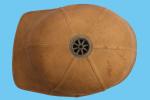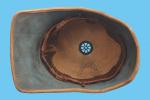-
Posts
1,761 -
Joined
-
Last visited
-
Days Won
3
Content Type
Profiles
Forums
Blogs
Gallery
Events
Store
Everything posted by Stuart Bates
-

Grenadier or Fusilier
Stuart Bates replied to Bear's topic in Great Britain: Militaria: Badges, Uniforms & Equipment
An inconvenient set of truths! Although looking at post #1 again I could also agree with the Paschal Lamb but I can't see a flag. -

Grenadier or Fusilier
Stuart Bates replied to Bear's topic in Great Britain: Militaria: Badges, Uniforms & Equipment
No. 82 is the one shown in Franklin's book and he dates it circa 1810. Now if this style and its variant made it to 1830 then the regiment can't be the 2nd if there is a 4 legged animal on the SBP. -

Grenadier or Fusilier
Stuart Bates replied to Bear's topic in Great Britain: Militaria: Badges, Uniforms & Equipment
I think I can see 4 legs but the Paschal lamb had one front leg wrapped around a flag pole. The legs here seem to be straight and forward. Did the lamb always have the flag? It could be a lion. -

Grenadier or Fusilier
Stuart Bates replied to Bear's topic in Great Britain: Militaria: Badges, Uniforms & Equipment
Leigh, found the book but the price is high, too high at $195 - $383. Thanks, Stuart -

Uniform ID
Stuart Bates replied to Stuart Bates's topic in Great Britain: Militaria: Badges, Uniforms & Equipment
The 2nd had sea green facings in 1751 even though they were The Queen's Own Royal Regiment of Foot and should have had blue which they obtained in 1768. There was a Clothing Warrant in 1768 so maybe this had something to do with it. -

Grenadier or Fusilier
Stuart Bates replied to Bear's topic in Great Britain: Militaria: Badges, Uniforms & Equipment
The 2nd had sea green facings in 1751 even though they were The Queen's Own Royal Regiment of Foot and should have had blue which they obtained in 1768. There was a Clothing Warrant in 1768 so maybe this had something to do with it. I don't think the Buffs had any other facing than buff at least after 1742. Leigh, what is the full title of the Parkins book? -

Uniform ID
Stuart Bates replied to Stuart Bates's topic in Great Britain: Militaria: Badges, Uniforms & Equipment
I have tried to avoid the issue of the single-breasted jacket as my reference information is confusing to say the least, and I need more time to digest it all. However, "in October 1797 the lapels were abolished and the lace and buttons sewn to the front of the now single breasted coat." This is a description of ORs jackets and Colonels determined whether lace was used on the buttonholes or not. If lace was not used then officers used a silk twist edging to the buttonhole. The jacket replaced the tailcoat from 1790 for regiments serving in the East Indies! I got this from Franklin's book on Napoleonic Uniforms. I don't suppose that he is in undress? BTW: Prue mentioned "Thomas" without my suggesting any of names I found in the 1815 list. Stuart -

Uniform ID
Stuart Bates replied to Stuart Bates's topic in Great Britain: Militaria: Badges, Uniforms & Equipment
Given the 1796 sword I guess we could say that the period is 1811 to 1822. -

Uniform ID
Stuart Bates replied to Stuart Bates's topic in Great Britain: Militaria: Badges, Uniforms & Equipment
The epaulette - -

Uniform ID
Stuart Bates replied to Stuart Bates's topic in Great Britain: Militaria: Badges, Uniforms & Equipment
I have an illustration of the 2nd's breast plate circa 1808 and it has the garter topped with a crown and the numeral 2 within. The 3rd has the same but with the dragon instead of the crown. -

Uniform ID
Stuart Bates replied to Stuart Bates's topic in Great Britain: Militaria: Badges, Uniforms & Equipment
Can't believe that I missed Britannia on the 9th so will go back through the book. I do have a name of "Hayes" and found 8 in the 1815 list, the earliest that I have. Two were with the Royal Marines so can be ignored. Prue says "Dad said that he was trading in the spice trade but may have been wrong. I think he would have been a 'Hayes'." I am waiting to see if she has a first name but it's all a bit iffy. The reference to the spice trade may be a clue with Col Thomas Hayes having the reference East Indies against his name in the 1815 list. However, the single epaulette would indicate he was a captain etc. when this portrait was done. Col. Thomas Hayes - promoted 1813 - East Indies. Lt Mark Hayes - promoted 1813 - 60th Regt. Breast plate to 1815 was rectangular. Capt. John Hayes - 11th Royal Veteran Battalion- retired 1807. Lt Charles Augustus Hayes - promoted 1811 - Nova Scotia Fencibles Infantry. Disbanded at Halifax in July, 1816 Capt. Henry Hayes - promoted 1811 - 84th (York and Lancaster) Regt. Yellow facings. Capt. Samuel Hayes - promoted 1796 - 8th West India Regt. Grey facings and Regiments.org says disbanded in 1803??? On Half pay. Any way of determining his rank? Stuart -

Uniform ID
Stuart Bates replied to Stuart Bates's topic in Great Britain: Militaria: Badges, Uniforms & Equipment
OK, Gorgets were abolished by decree of King William IV in 1830. However, they were permitted to be worn by officers in England up to Christmas 1831 and by those abroad until 1832. So not much help there. -

Uniform ID
Stuart Bates replied to Stuart Bates's topic in Great Britain: Militaria: Badges, Uniforms & Equipment
Did not all infantry regiments of this era, with the exception of the foot guards, always have the regimental number on the breast plate? I checked Franklin's book on British Napoleonic Uniforms and he confirms that. I did not find a plate with Britannia nor an eagle either. Franklin also states that gorgets were worn with two rosettes - pity that I forgot I had this book. Does anyone know when gorgets were discontinued? Stuart -

Uniform ID
Stuart Bates replied to Stuart Bates's topic in Great Britain: Militaria: Badges, Uniforms & Equipment
Is that another rose fixing peeking out on the right had side as viewed? Must be - see my next post. -

Uniform ID
Stuart Bates replied to Stuart Bates's topic in Great Britain: Militaria: Badges, Uniforms & Equipment
The epaulette to the right shoulder only was specified for battalion company officers in 1768, and in 1811 was changed to have bullion. In 1829 the epaulette was worn on both shoulders. This would, prima facie, put the uniform 1811 - 1829, but by the look of the fellow I would say closer to the 1811 date. The rose ornament to the throat may indicate Yorkshire or Lancashire? Any help much appreciated and the winners get a free BBQ with the lovely Prue. Stuart -

Uniform ID
Stuart Bates replied to Stuart Bates's topic in Great Britain: Militaria: Badges, Uniforms & Equipment
And a closeup of the sword hilt. -

Uniform ID
Stuart Bates replied to Stuart Bates's topic in Great Britain: Militaria: Badges, Uniforms & Equipment
Here is a closeup of the cross belt plate. -

Uniform ID
Stuart Bates replied to Stuart Bates's topic in Great Britain: Militaria: Badges, Uniforms & Equipment
She had the photo of the painting "restored" and here it is. -
I was accosted in the street by Prue who said "Just the man I am looking for." When I recovered it transpired that she has an old painting of a long distant relative (perhaps) and thought that I could ID the uniform if not also the man. Well obviously not which is why I am posting. A photo of the painting.
-
And another. These forage caps are among my favourite pieces of headgear. This one to the Nottinghamshire and Derbyshire Regiment( Sherwood Foresters). It has a beautiful blue enamelled badge. This regiment was formed in 1881 with the 45th Regiment (Nottinghamshire) becoming the 1st Battalion and the 95th Regiment (Derbyshire) becoming the 2nd Battalion 3rd Battalion was formed from the Chatsworth Rifles, or 2nd Derbyshire Militia 4th Battalion was formed from the Royal Sherwood Foresters, or Nottinghamshire Militia 5th Battalion from the 1st Derbyshire Regiment of Militia
-
I am not at all surprised that it was disliked by the soldiery. Let's face it, it is a rather ugly helmet with Germanic styling which would not have gone down well with the British. I have no idea why the rippling to the sides, and it would appear to give no more protection from the sun than the Colonial pattern helmet (Zulu & Boer war) which it was meant to replace. And the steep front brim would not have overcome the criticism of the Colonial's front peak causing problems when the men were firing their rifles in the prone position. The removal of the side rosettes and the ventilator cap is probably explained by the fact that these could be re-used. The helmet seems quite diminutive against the normal Colonial pattern This example was found in garage in the village of Banwell, Somerset, UK. However, I am very pleased to have obtained it and just as pleased to share. Stuart




